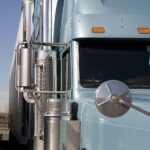Staying afloat in 2025 is a challenge everyone is facing. Threats of tariffs, rising prices on truck repairs and new equipment, high credit card interest rates and loan APRs, and increasing minimum wage rates in many states all impact your business’s fluidity.
It’s essential that you track different key financial metrics to stay solvent and have the money needed to help grow your business. Your trucking company can manage these changes if you carefully track your revenues and expenses and prepare yourself for sudden changes.
The Trucking Industry in 2025
In 2025, the trucking industry is seeing the following characterizations.
- Freight volumes are expanding at a moderate pace, influenced by economic conditions, inflation, and high interest rates.
- Higher fuel prices, maintenance costs, and wages are making it harder to purchase new or used trucks and trailers and afford driver benefits.
- Overcapacity is impacting spot rates, which are affected by supply and demand, interest rates, and political instability.
- Technology like AI and self-driving trucks is impacting the trucking industry, and the right tools can help your company save money on fuel, tolls, and maintenance.
The current administration has tabled sustainability and environmental protections for now, but it’s still something to keep in mind. Some states are still pushing towards alternative energies like electric trucks to limit the emissions from petroleum-based products.
Your Business’s Financial Health Starts With Revenues
For your trucking company to succeed, you need to be profitable. There are several ways to track and generate the revenue you need to achieve profitability.
Operating Revenue
Your trucking company’s operating revenue measures how much of the money you make is eaten up by expenses. The smaller the percentage, the better. Ideally, keep your operating revenue below 90%.
This means 90% of your revenues cover the bills, but 10% can go into your savings and get reinvested to help grow your business. Successful trucking companies often have operating revenue at 85% or lower.
Carefully tracking your monthly revenues and comparing them to your bills is your first step towards managing how well you’re managing your money. It’s also important that you’re following up with clients to ensure they pay you in a timely manner.
Revenue Per Mile (RPM)
Your per-mile rate is the amount you receive for each mile driven. Your per-mile rate needs to cover your expenses. Think of every expense you have:
- Building and yard maintenance and upkeep
- Driver and office staff’s salaries/wages
- Fuel costs
- Health insurance premiums
- Marketing
- Office rent/building loan
- Permits and licenses
- Taxes
- Truck and equipment insurance
- Truck maintenance and repairs
- Trucking technology and software
- Utilities (Electricity, heat/cooling, internet, phones, and water)
Calculate your monthly expenses and aim for profits that exceed that total by about 8%. Some industry experts feel a lower profit margin of 4% to 6% is enough, but it’s better to be at 8%. A higher profit margin helps you build a stronger cash reserve for slow periods or emergencies.
If you’re well out of these averages, it’s time to lower your monthly expenses.
Build a Strong Cash Flow
Businesses within the trucking industry rely on a strong cash flow. A lack of savings can destroy a company, and it’s easier to handle emergencies when you have a strong liquidity. Even profitable businesses can fail without sufficient cash flow.
This is why the previous two points are important. If you’re not charging enough and getting your expenses low enough to ensure you have money building up. As you do find yourself with more revenue than expenses, don’t become tempted to splurge on items you want for your company vs. need.
There are a few things to look at when it comes to improving your cash flow.
- Cash Conversion Cycle (CCC) – CCC is the time it takes for your trucking company to convert accounts payable into cash. You’ve delivered goods, and now it’s 60 days, and you haven’t been paid. Until you are, it’s hard to convert that unpaid invoice into cash for your savings or to reinvest in your business.
- Current Ratio – This is a simple calculation of your assets right now by the debt you owe right now. You want to have enough cash in savings or other accounts to cover your debt.
- Days Sales Outstanding (DSO) – How long does it take clients to pay you? If you have clients taking 60 days, it’s time to consider shortening these payment cycles. The longer you wait for payment, the more it strains your cash flow. If they won’t shorten them, a freight factoring arrangement eases the strain by ensuring you’re paid immediately.
Get Your Debt and Expenses Under Control
Controlling costs is important, especially when profit margins are tight. We’ve talked about revenues above, but you also need to control debt by factoring in the following metrics.
- Cost Per Mile (CPM) – How much are you spending for every mile a truck travels? Do this by calculating the fixed expenses (truck lease or loan, insurance, licenses, and permits) and variable ones (fuel, repairs, maintenance, tolls, and driver wages).
- Debt-to-Equity – Calculate your business assets and investment you’ve made into your trucking company and compare them to the total debt you owe. If your debts exceed your assets, it’s a sign of high financial risk. This impacts loan APRs and interest rates because you have a low business credit rating.
- Debt Service Coverage Ratio (DSCR) – Can you cover your debt using your operating income? Aim for a DSCR of 1 or higher. Get this score by dividing your net operating income by your total debt.
- Driver Turnover Rate – How many drivers leave your company over a year. Divide that by 12 to get an average monthly turnover rate. This impacts your expenses as you may have to pay for contracted unused vacation days.
- Maintenance and Repair Per Mile – Over a month, what are you spending on maintenance and repairs? Divide that by the number of miles driven that month to get an idea of how much you spend per mile.
- Miles per Gallon (MPG) – How many miles are driven and how much does that cost? Fuel prices fluctuate, so you need to find the best ways to reduce this expense. Fuel discounts with a freight factoring company is one of the easiest discounts to get.
Freight Factoring Helps You Navigate Changes in 2025
What’s most important is that you carefully track your finances and plan ahead. It’s impossible to predict how the rest of the year is going to go. As the cost of living increases with health insurance rates, grocery prices, and electricity rates increasing in some areas, people will start to change their habits. This could impact one of the busiest times for the trucking industry – the holidays.
Build a strong cash reserve and make sure you’re not falling behind on bills. Do everything you can to keep your credit rating from falling. And most importantly, be ready to seize any opportunity to grow your fleet and build your client list.
Saint John Capital helps you achieve your goals by offering freight factoring arrangements for the lowest fees possible. With both non-recourse and recourse factoring options, you enjoy the benefit of having insurance against a client’s unexpected shutdown or bankruptcy. It’s one of the best ways to protect your company from having to shoulder another company’s sudden debt. Reach us by phone or email to learn more.











